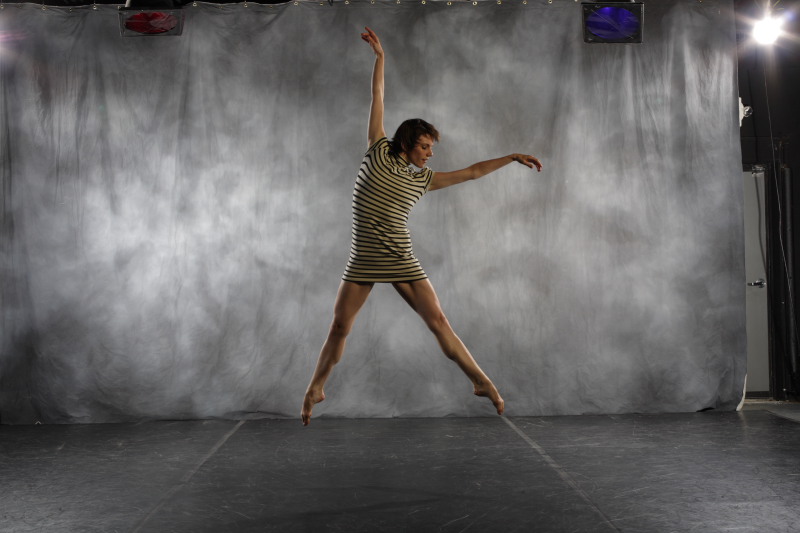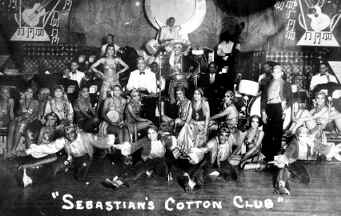
To define Jazz dance is to hold Jazz in a static state. Jazz dance is dynamic and ever changing, as all art forms are. In many ways, we truly don’t want to define Jazz dance; we want to live it, to feel it, to move with it. Jazz is as diverse as the people who create it, and it is through this broad, melting pot concept of Jazz dance that we start to find the essence of this truly American art form.
Having taught Jazz dance to thousands of people throughout the years, one of the first techniques I use is to simply have people sway and swing to the music. The famous saying, “It don’t mean a thing if it ain’t got that swing,” really rings true. The quality of “swing,” and the releasing and retrieving of energy into the earth is what starts the dance for me. Students need to feel the sway of movement to the music. Initially it’s about going with the flow, allowing the body to relax and feel at ease. Students lose their inhibitions, laugh, enjoy and find themselves dropping into the sensation.
The lowered center of gravity that results from this is another key element of jazz dance. Jazz dance is about “getting down.” Jazz dance, to a certain degree, is the antithesis of ballet — the erect spine and lifted center of ballet creates a totally different aesthetic from that of jazz dance. The Jazz dancer uses the bended knees, or I could say “plie,” to drop their center and get into the movement. Jazz dance can be lifted, and the spine long, but for me Jazz starts in a released and grounded place. The dancer is into the weight of the body, muscles are relaxed, and the mind is free and easy.
Historically, Jazz dance evolved with Jazz music in the bars and honkytonks where people were simply feeling and moving to the music. Nineteenth century New Orleans, Prohibition Chicago speakeasys, blues clubs of the Mississippi Delta, and Harlem’s Cotton Club all have a place in the history of Jazz. The elements that we recognize easily today as Jazz grew from these people and places. The wave of spine and limbs, and the isolation of body parts. A hip here and arm there, a shoulder shrug and flick of the head. A torso inclined forward, a contracted pose. These isolations and articulations, originally inspired through acts of flirtation, titillation and the pain and joy of the everyday, ultimately evolved into what we call the “style” of Jazz dance.
By lacing the protocol of ballet over and under the elements of Jazz you get what we call Jazz dance technique. But to ultimately learn Jazz you have to allow yourself to feel and move to the music. This music is full of poly-rhythms and syncopations that bring the pulse of a country to the keys of a piano, the blow of a horn, and the beat of the drum. Jazz music is full of the dissonant sound of a society ever changing, in opposition and contradiction to itself
In Jazz music one hears the grind and clank of an industrial nation, the chant of a migrant worker and the glow of a Broadway beat. A Jazz dancer articulates, with sharp body lines of angle and opposition, as well as lines of softness and curve, the sounds of a country and a people in vibrant growth and development, some good, some bad. Jazz moves are further nuanced with the qualities of a percussive beat, a hit, a slap, a lick and, when it’s right, a sensual strut and a sexy thrust. As dancers move through the Jazz experience they are ultimately creating for themselves a style, a quality of movement that echoes a sense of attitude, presence and an “aesthetic of cool.” Jazz is hip, it’s here and now, its contemporary, and it’s cool.
What does it mean to be cool? Physically, a lowered brow, a dropped chin or a snap of the finger can show cool. But the aesthetic of cool starts on the inside. Words such as “vibe,” “hotness,” “sizzle,” and the phrase “Let it rock,” serve us well in the exploration of Jazz and the aesthetic of cool. The word “Jazz” alone can actually help people find the appropriate state of mind; having a room of people speak, if not shout, the word “Jazz” is a fun exercise. (The use of the tongue, sneer of the lips and final hissing sound of the “z” can resonate through the body, allowing the word, sound and essence of Jazz to exist together.) Cool is a state of mind.
Learning Jazz dance is an opportunity to find oneself in movement that is uniquely your own, yet connected to a defined culture and rhythm. Challenging to define due to its vast associations, Jazz is the rhythm of the individual heart and the beat of a collective soul. Jazz is an American folk dance, a state of mind, a culture and a way of life.
 Doug Yeuell has worked as a dancer, dance educator and administrator in the Washington, DC area since 1982. Currently, Mr. Yeuell is the Executive/Artistic Director of Joy of Motion Dance Center (JOMDC), Washington, D.C.’s leading center for dance. JOMDC is dedicated to offering a broad spectrum of dance forms and learning opportunities for adults and children alike. In addition to his administrative duties, Mr. Yeuell has taught Jazz at JOMDC since 1982. Mr. Yeuell has studied with such jazz greats as Matt Mattox, Luigi, Billy Siegenfeld, Lynn Simonson and Joe Orlando. From these experiences, Mr. Yeuell has developed his own unique style of jazz focusing on the percussive, rhythmic energy of jazz, its passion, style and sensuality. Classes are taught with a strong emphasis on working from one’s center, the core, and allowing movement to flow from the inside out. Classes are a constant exploration of the beauty of pure movement. At a beginning level, emphasis is placed on building students natural ability to dance and feel movement from a jazz perspective. At more advanced levels, students are challenged through intricate combinations to express themselves through the inspiration of music and choreography to discover the true essence of jazz movement.In addition to teaching at Joy of Motion Dance Center, Mr. Yeuell has an active career as a teacher/artist at numerous institutions around the country and the world. Mr. Yeuell recently served as guest artist and instructor at ATIK Dance & Movement Arts Festival in Klagenfurt, Austria . He has taught jazz for James Madison University Department of Dance, George Mason University, Georgetown University, Gallaudet University and Catholic University, and has held faculty positions at The Washington Ballet, and The Kirov Academy Summer Programs.
Doug Yeuell has worked as a dancer, dance educator and administrator in the Washington, DC area since 1982. Currently, Mr. Yeuell is the Executive/Artistic Director of Joy of Motion Dance Center (JOMDC), Washington, D.C.’s leading center for dance. JOMDC is dedicated to offering a broad spectrum of dance forms and learning opportunities for adults and children alike. In addition to his administrative duties, Mr. Yeuell has taught Jazz at JOMDC since 1982. Mr. Yeuell has studied with such jazz greats as Matt Mattox, Luigi, Billy Siegenfeld, Lynn Simonson and Joe Orlando. From these experiences, Mr. Yeuell has developed his own unique style of jazz focusing on the percussive, rhythmic energy of jazz, its passion, style and sensuality. Classes are taught with a strong emphasis on working from one’s center, the core, and allowing movement to flow from the inside out. Classes are a constant exploration of the beauty of pure movement. At a beginning level, emphasis is placed on building students natural ability to dance and feel movement from a jazz perspective. At more advanced levels, students are challenged through intricate combinations to express themselves through the inspiration of music and choreography to discover the true essence of jazz movement.In addition to teaching at Joy of Motion Dance Center, Mr. Yeuell has an active career as a teacher/artist at numerous institutions around the country and the world. Mr. Yeuell recently served as guest artist and instructor at ATIK Dance & Movement Arts Festival in Klagenfurt, Austria . He has taught jazz for James Madison University Department of Dance, George Mason University, Georgetown University, Gallaudet University and Catholic University, and has held faculty positions at The Washington Ballet, and The Kirov Academy Summer Programs.
As an artist, Mr. Yeuell has choreographed and performed professionally for numerous companies in the D.C. area. Mr. Yeuell also serves as the Artistic Director of his own performing company, Jazzdanz/dc, a professional dance company that explores the many facets of jazz dance, from classical jazz to blues, Broadway jazz, swing, funk and new age.

Thanks for the eloquent description!